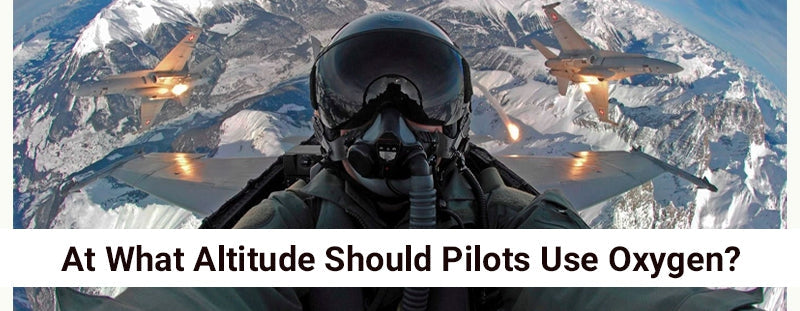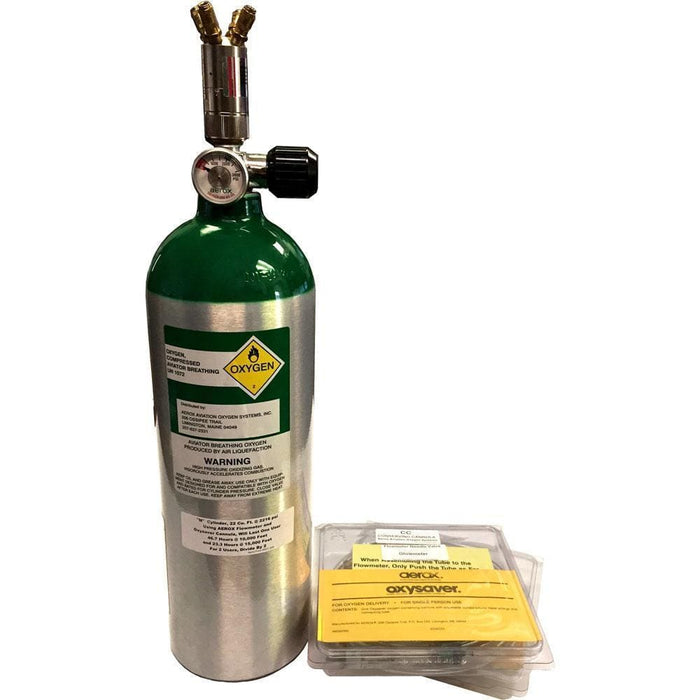At What Altitude Should Pilots Use Oxygen? (It’s Lower Than You Think)
What kind of pilot would fly after a drink? Not you, right? Good. Same here, but if we are being honest, how many of us have experienced signs of hypoxia (oxygen deficiency) while at the controls?

What kind of pilot would fly after a drink? Not you, right? Good. Same here, but if we are being honest, how many of us have experienced signs of hypoxia (oxygen deficiency) while at the controls?
Hypoxic flying is impaired flying even if we aren’t at an altitude where supplemental oxygen is legally required. Even a symptom as mild as decreased night vision means we are piloting while not at our best.
When flying an unpressurized plane, a good oxygen system setup should be part of our standard equipment whether our flight plan takes us to higher altitudes or not. Despite what we used to believe, oxygen is not just for fighter pilots or lightweights. It’s something we all need to plan for.
If supplemental oxygen has been on your back burner list or you just want to learn more about staying properly oxygenated in the cockpit, stick around. We will share why you may want to consider using oxygen at a lower altitude than you thought plus how to tell for sure when you personally need oxygen.
FAA Supplemental Oxygen Requirements

Let’s start with the regulations. The oxygen requirements for aviation say that supplemental oxygen for pilots is always required when flying at cabin pressure altitudes of 14,000 feet and higher. Passengers must be offered oxygen at 15,000 feet. If you are flying at a pressure altitude of 12,500 feet to 13,999 feet, once you hit the thirty-minute mark, you need to put on that oxygen.
How to Tell if You Need Supplemental Oxygen
Is following the FAA oxygen rules enough to stay safe? Not necessarily. The only way to know your oxygenation status for sure is to check your levels using a pulse oximeter, also known as an SpO2 meter.
When we breathe, the oxygen taken in by our lungs is transferred into our bloodstream and travels throughout our bodies so all our tissues receive oxygen. The amount of oxygen bonded to our red blood cells and circulating in our blood is referred to as our oxygen saturation (SpO2) level.
SpO2 levels are measured as a percentage with “normal” levels being 95% or higher. If we check our SpO2 levels during flight and see saturations lower than 90%, that means our body needs extra oxygen no matter what altitude we are currently at. Medical conditions, smoking, a sedentary lifestyle, and living at sea level can all cause our oxygen saturation to drop off even faster and at lower altitudes.
A simple SpO2 device can be purchased online, in pharmacies, and at big box retailers. The most common style of pulse oximeter is one that you slide your finger into, but easy-to-wear wristwatch style models are also available.

Pro Tip: If you use a fingertip design, know that both cold fingers and dark nail polish can produce artificially low oxygen readings. Warm up your hands and try to avoid wearing dark polish to get the most accurate readings.
What Causes Hypoxia?

Our bodies, and especially our brains, need the oxygen molecules in the air to pass into our bloodstream and be delivered to our tissues in high enough concentrations to support proper function. As we fly to higher altitudes, atmospheric pressure is decreased, and the air becomes less dense.
Although the air still contains twenty-one percent oxygen molecules, with the decreased “partial pressure,” when we breathe those molecules in, fewer are pushed through the alveoli of our lungs and into our bloodstreams. We either need to breathe in an increased percentage of oxygen or we need extra pressure to help force the existing oxygen into our blood. Hypoxia occurs when our body tissues aren’t receiving enough oxygen.
Symptoms of Hypoxia
Symptoms of hypoxia in pilots start out subtle. They intensify over time and with increased altitude. The initial symptoms vary from person to person and can include:
- Decreased night vision
- Blurred vision
- Black and white vision
- Tunnel vision
- Mild euphoria
- Increased breathing rate
- Rapid heartbeat
- Sweating
- Tingly skin, lips, fingers, and/or toes
- Dull headache
- Fatigue
- Confusion
- Decreased reaction time
Because we each respond differently to hypoxia, it’s hard to recognize those initial subtle signs and symptoms if we aren’t looking for them. The mild euphoria and mental confusion that often come with hypoxia can cloud our judgment and keep us from realizing there is even a problem. This is where a pulse oximeter comes in handy since it provides quantifiable and actionable health data.
The FAA’s hands-on hypoxia training courses provide another fantastic awareness-building opportunity. These courses put pilots in a controlled altitude simulator where they can observe and note their personal responses to hypoxia. This knowledge makes it easier to recognize the onset of hypoxia in ourselves.
At What Altitude Do I Need Supplemental Oxygen?

So, what’s the bottom line? At what altitude do we need extra oxygen? You are probably familiar with the saying “legal doesn’t mean safe.” That certainly applies here. Just because the FAA doesn’t require pilots to use supplemental oxygen below 12,500 feet, it doesn’t automatically mean it’s safe to leave our oxygen masks or cannulas stowed.
Although the 12,500-foot rule is still in place, the FAA recognizes that a pilot’s blood oxygen saturation (SpO2) levels can drop below the 90% threshold and initial hypoxia symptoms can appear between 7,000 and 10,000 feet—well below the 12,500 feet legal level.
For these reasons, to improve pilot safety, the FAA now recommends that pilots use supplemental oxygen when flying above 6,000 feet at night and above 10,000 feet during the day.
Note: Decreased night vision is one of the first symptoms of hypoxia since our eyes require increased levels of oxygen at night. This symptom has been documented at altitudes as low as 5,000 feet. On average, women experience the effects of hypoxia and need supplemental oxygen 2,000 feet lower than men do.
If you want to know more about supplemental oxygen:

|
Aerox Oxygen SystemsGo longer between oxygen refills with the lightweight, durable, all-metal Aerox oxygen system that allows you to fly at higher, more fuel-efficient altitudes and summit hazardous weather for smoother, safer ops. |
For more pilot health topics:
- Pilot Hypoxia: How to Recognize and Respond to the High-Altitude Threat
- BasicMed Explained (Guide to Understand the Essentials)
- 15 FAA Medical Certificate Disqualifying Conditions for Pilots
It’s Your Turn
We would love to hear from you. What’s the lowest altitude you’ve felt any hypoxia symptoms at? Do you carry and use an SpO2 meter while flying? Has it helped you recognize hypoxia? Share your stories and advice for other pilots.




3 comments
I live in a mountain environment and cannot stress enough that most of the FAA regs regarding oxygen are assuming the pilot is physically fit, no anomalies on the Med Cert, and no “hidden” age related issues. Every pilot worth his or her salt knows that problems can arise out of nowhere, and very very quickly can spiral out of control.
We all love to fly higher up to avoid those nasty bumps and weather anomalies, but flying in high altitude is just like driving a 4×4 into hard terrain with no spare tire. I carry an Aerox EMT-3 system, it was on sale for $300 dollars. It and a decent SpO2 pulse oximeter are WELL worth the investment. Keep your bottle inspection current, and have peace of mind knowing if you have to take a slightly higher altitude detour you can. Too many pilots (even very experienced ones) are no longer with us due to well intentioned, but poor planning in high altitude flight.
As a thirty year USAF pilot, I have been through the altitude chamber experience many times. I have to say that if I were experiencing actual hypoxia,
it’s so insidious that I don’t think I would recognize the symptoms very soon. Very scary.
I carry supplemental oxygen at all times, and although I live at a higher elevation (3 miles from KFNL at 5000’), as I’ve aged, I have found it necessary to use the O2 at any elevation above 10,000’. I have a good pulse oximeter—not a $15 el cheapo—and it confirms that my O2 percentage will drop below 90% not much higher than 10,000’ without supplemental oxygen. The FAA oxygen rules are sorely out of date and unrealistic for most of us, no matter what our physical condition and age may be.